As parents, there’s no better feeling than seeing our children happy. And we often will do whatever we can to help them experience the feeling of happiness—finding that sold-out gift they want for their birthday, taking them for a surprise ice cream outing, or letting them go out to the movies with their friends on a school night.
Seeing our children happy makes us happy, but it also makes us feel as if we as parents are doing something right. Parenting can often feel like a heavy slog, with not much immediate reward, so seeing our children experience happiness can be incredibly reassuring that we are doing a good job.
However, it is important for our children to not be happy. Yes, you read that right! Children need to feel a wide range of emotions as they grow up that are quite far from happiness. Feelings like sadness, fear and disappointment. In fact, a recent study looked at the emotional range of 37,000 people and found that those who experience “emodiversity,” an abundant range of emotions, have better mental health, decreased depression, better physical health and know how to handle a wide range of behavioral situations.
If you’re not convinced, I highly recommend you watch the Disney Pixar film Inside Out. In the movie, the main character is a young girl named Riley who leaves the only home she’s ever known and moves across the country. The story of that major life transition is portrayed through the perspective of Riley’s emotions: Joy, Fear, Anger, Disgust, and Sadness.
When Riley is struggling with the move, Riley’s mom responds by telling her to just be their “happy girl”. In this situation, Riley’s mom may think she’s just encouraging her daughter to put on a brave face, but Riley took that suggestion as “I’ll be letting down my family if I’m not looking like I’m happy.” That one simple statement made Riley hide her true feelings about the move from her parents and caused her emotional distress throughout the rest of the film.
How often have we told our own kids to just cheer up and get over it? What if, instead, we listened to what was wrong and sat with them in it? Sometimes all we want as humans is to be heard. We don’t necessarily need the problem solved right away. Our kids are the same way.
As the film goes along, we see that all of Riley’s emotions play a pivotal part in her ability to experience happiness. This is notably portrayed when Riley becomes so angry at being pulled away from her home and life back in Minnesota that she decides to run away. In this scene, Riley experiences all of her emotions, especially fear and anger. When Riley eventually decides to come home, she is able to understand that all she needs is her family to be happy, it doesn’t matter where they are, as long as they are together. We see that to fully appreciate her family and feel immense happiness when she is with them, she had to experience the fear and sadness of potentially losing them.
As parents, sadness, fear, and anger aren’t feelings we’d necessarily raise our hand to let our child feel, but they are important to growth. A study in the journal Emotion showed that experiencing feelings such as anger can be beneficial to particular situations.
It’s important for us as parents to let our children try out new feelings and experience the pros and cons they have. It is important for a child to feel fear when they are climbing something tall for the first time. They need to understand that if they don’t put their foot in the right place, they could fall.
Try to help your child experience a range of healthy emotions when you can. Let them climb a little higher than usual at the park and feel a healthy sense of fear. Ask them what they’ve always wanted to accomplish, and help them get there to experience the feeling of pride. When they don’t do well on a test, help them understand that their frustration can be a motivator for next time. After they work hard, study well, and get a better grade on the next test, they’ll feel even happier after experiencing the sadness and disappointment of not doing their best.
I do want to point out, though, that while occasional sadness is healthy, persistent sadness is not. The Mayo Clinic defines depression as “a mood disorder that causes a persistent feeling of sadness and loss of interest. It affects how you feel, think, and behave and can lead to a variety of emotional and physical problems.” If your child is showing signs of depression, it is important to talk to them about it and potentially find a mental health care professional who can dive deeper into the feelings with them.
By letting your child experience a wide range of emotions, you are doing your job as a parent. You are teaching them how to navigate tough situations, cope, problem-solve, and develop empathy, all of which they will need to thrive when they are older. But don’t worry, happiness is still important. Finding opportunities to bring joy and fun experiences to your children is one of the best parts of parenthood.. Maybe to start: an Inside Out family movie night!
